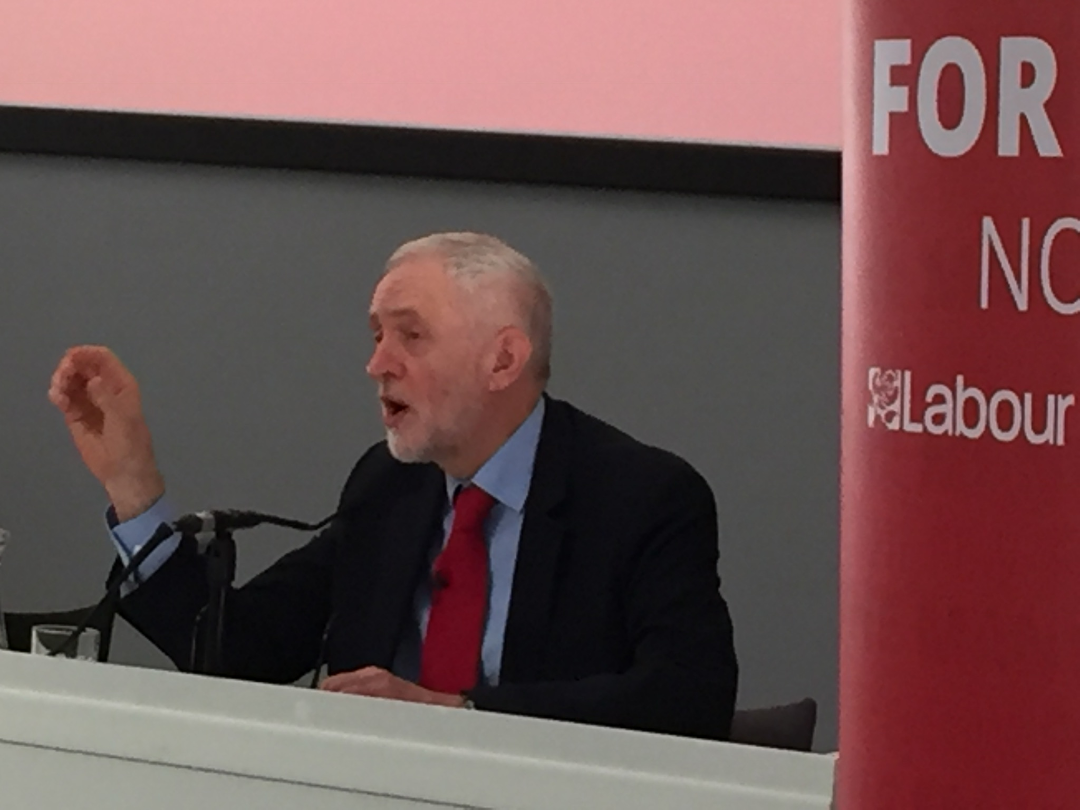Today saw the launch of Labour’s Green Paper focused on social housing – ‘Housing for the many’ – in Westminster. Together with Shadow Housing Secretary John Healey and the Leader of Leeds Council, Judith Blake, Jeremy Corbyn set out Labour’s housing stall for the local elections at the start of May and the General Election whenever it comes (speech here).
For Red Brick readers, the document addresses positively many of the most common themes seen in these pages over the past seven or eight years.
Jeremy Corbyn answers questions from journalists and the housing world at the launch.
‘Housing for the many‘ traces the history of social housing and its importance in meeting housing need, the failure to invest adequately in new social housing since 1980, and the Tories’ efforts to remove it entirely since 2010. Without repeating the evidence of the scale of housing need, well documented in these pages, or summarising the whole document here – it is worth a read in its entirety – we would like to highlight some key issues that have been been raised time and time again on Red Brick over the years. To mention just a few:
- Tenant empowerment will be a key feature of the new approach. A new national voice for tenants will be established, tenants’ groups will be actively supported, and there will be consultation on a new requirement that tenants should sit on housing association boards. The regulatory regime will be strengthened to improve consumer standards and tenant involvement. Tenants’ rights will be strengthened – with the ban on long-term tenancies ended.
- There will be a new definition of ‘affordable’ housing to tackle the increasing bizarre use of the word by the Conservatives. Labour will return to the key notion of ‘social rent’ with rents set by the existing national formula, and will scrap the Tories’ bogus ‘Affordable Rent’ (with rents up to 80% of market rents) in favour of a new ‘Living Rent’ linked to one-third of local earnings aimed at key workers and people on moderate incomes.
- Recognising that building market homes alone will not tackle the housing affordability crisis, Labour will gear up to building 100,000 genuinely affordable homes a year, achieving 1 million over a decade. This is around six times the amount being achieved now and ‘would reach levels last achieved in 1978’.
- There will be a proper focus on housing through a new stand alone Ministry and external checks on the progress Ministers are making towards meeting the housing targets.
- Building social housing makes good economic sense – the document references the SHOUT report by Capital Economics – and will improve the public finances in the long term by reducing the cost of housing benefit.
- One in eight social homes still fail the ‘decent homes’ standard despite the £20 billion investment improving 1.4 million homes made by the last Labour government. There is a new crisis – across all tenures, but here we are addressing social housing – in terms of fire safety and the urgent need to secure significant improvements following the appalling Grenfell fire. Grenfell survivors contributed to Labour’s review, and the document commits Labour to installing sprinklers in high rise flats.
- Labour will act to stem the loss of social rented homes from the stock. This will include ending the scandalous practice of converting social rent homes to the much higher ‘Affordable Rent’ when they become empty, suspending the right to buy, and abandoning the Tories proposed policy of selling ‘high value’ council homes to fund a new housing association right to buy.
- The plans will herald the start of a major shift away from personal subsidies towards investment subsidies – from ‘benefits to bricks’. Money will go towards ensuring affordable homes are built, not letting rents rip and letting housing benefit ‘take the strain’. Critically, Labour will restore the £4 billion housing investment programme that was in place in 2010 and look to negotiate a new 10 year rent settlement to keep rents affordable for tenants as well as supporting a sustained investment programme and a new ‘decent homes 2’ programme.
- Labour’s investment policies will also include lifting the council HRA cap to prudential levels, and reviewing the way borrowing is recorded in the national accounts. New development on public land will be required to meet affordable housing requirements. Housing associations will be regarded as a key part of finding the solution to the affordable housing crisis, but there will be a renewed expectation that they will have social purpose at their core.
- In private developments, Labour will remove the ‘viability loophole’ which allows developers to dodge affordable housing obligations and will change other planning rules which inhibit the provision of affordable homes.
- Although not a paper that focuses on Labour’s social security policies, there are specific commitments to end the hated bedroom tax, protect housing benefit for the under 21s, and to pause and fix Universal Credit.
- In regeneration, there is a repeated commitment to a ballot when demolition is proposed. There will be a minimum requirement that there should be no loss of social rent homes and new guarantees for existing residents.
- There will be new commitments to improve design and reduce carbon emissions, together with new minimum space standards and a further extension of the Lifetime Homes standard.
It should be noted that, as a Green Paper, Labour is still open to comment and to revision of the policies before they are finally agreed. Everyone is encouraged to address the outstanding questions that the document highlights.
Labour’s document was launched by Shadow Secretary John Healey, Leeds Leader Cllr. Judith Blake, and Opposition Leader Jeremy Corbyn at a packed gathering in Westminster. 
5 replies on “Corbyn sets out Labour’s housing stall”
Thanks for sending this. I responded as below.
“This document is very welcome along with the priority given to housing. It is important that the great variation between and within regions is recognised, particularly the cost and availability of existing housing, and that a wide range of solutions are made available.
Q1, The “correct” weight that a Labour Government should give to the components of our programme: social rent, living rent, and homes for low-cost ownership is therefore dependent upon the mix of the local need.
Q2, it is difficult to see under what circumstances such a priority could be justified.
Q3 –
Q4 This needs to be flexible both in the first instance and because the need will continue to change as the economy changes.
Q5 Local authorities should carry out a (broadly) costed assessment of needs and make a statement of what powers they need and public debate should be involved. A sense of urgency might be generated by pre-announcing bidding-rounds and initially allowing the best-prepared to make an early start.
Q6 Yes.
Q7 Some financial incentives will be required.
Q8 Yes.
Q9 –
Q10 –
Q11 A first choice for those who build or those who will live in affordable housing? You will hardly need to incentivise the tenants!
Q12 A survey of existing heating systems and a bulk-tender of installation programmes of modern boilers could be helpful. There is likely to be a shortage of capable firms with fully-trained staff in some areas.
Q13 –
Q14 Yes, but be aware that many tenants now have little experience of collective representation and will need training and support to take on an enhanced role.
Q15 I very much doubt that modern housing associations still employ many suitable staff. There will be a significant need to boost this, possibly through some kind of national body with a remit to train and advise.
Q16 –
I am delighted to see this “Cinderella” policy area at last getting the attention it deserves.
Paul Martin
[…] this GP, prepared and delivered with all the resources of government, and the one produced by Jeremy Corbyn and John Healey for Labour earlier in the year. One fiddles at the edges and is going nowhere, the other is a genuine agenda […]
[…] Green Paper, prepared and delivered with all the resources of government, and the one produced by Jeremy Corbyn and John Healey for Labour earlier in the year. One fiddles at the edges and is going nowhere, whilst the other is a genuine […]
In my opinion, housing for workers is very good because it helps them to keep their homes. Judging from the very high house prices and many who did not reach that price, the existence of housing for workers was very helpful. And housing for workers should be the responsibility of the central government. The provision must follow the rules of the public housing, with good location planning. biesterbos.nl
[…] This year we have had the debate around the government’s rather pathetic and thin Green Paper – (Red Brick comment here) – followed by Labour’s more impressive and thought out version ‘Housing for the many’ (Red Brick comment here). […]